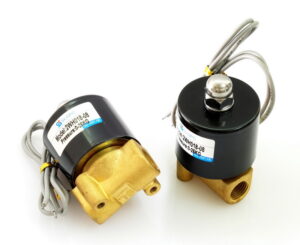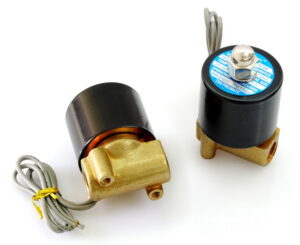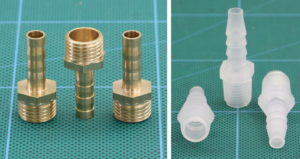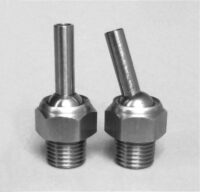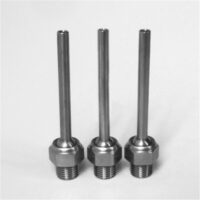Solenoid Valves
There are various valves suitable for water drop photography and if you search online you can see people using many different models. Currently, the two main types I use are the Shako PU220ARs and SLGPC PU220ARs. I have several other makes & models that come out occasionally.
Over the years I have tried many different makes and models. Some good, some not so good. My all time favourite is a noname Chinese clone of the PU220AR. Unfortunately I can no longer buy these and haven’t used them in a while.
Valves with different sized threads are available and sometimes within the same range, for example the Shako PU220AR which has different models:

Buying different valves types may mean different thread sizes and so you will need nozzles that fit. I have personally standardised on valves with a 1/4″ NPT thread. This size is very common and means the same nozzles can be used on all my different valves. Over the last few years I have found myself using the Shako valves almost exclusively though. This is down to convenience; at the best of times aligning drops is a pain and when using different sized valves it becomes a right royal pain.
Common Valves
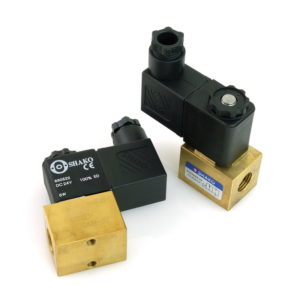 The Shako PU220AR-02. This has become the gold standard for water drop valves. Repeatable performance, reliable, and can produce relatively small drops.
The Shako PU220AR-02. This has become the gold standard for water drop valves. Repeatable performance, reliable, and can produce relatively small drops.
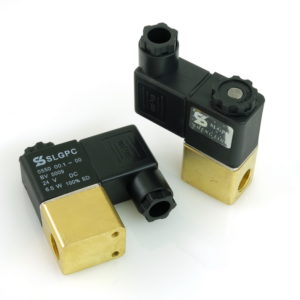 SLGPC PU220AR-02. Similar but not identical to the Shako (smaller valve block but same size orifice).
SLGPC PU220AR-02. Similar but not identical to the Shako (smaller valve block but same size orifice).
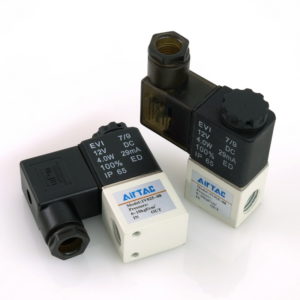 AirTAC 2V025-08. Good performance and fairly cheap, but, the AirTACs have an aluminium block that needs more TLC than the brass ones and means more frequent and careful cleaning.
AirTAC 2V025-08. Good performance and fairly cheap, but, the AirTACs have an aluminium block that needs more TLC than the brass ones and means more frequent and careful cleaning.
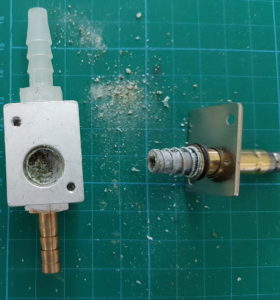 An AirTAC that wasn’t cleaned properly the last time it was used.
An AirTAC that wasn’t cleaned properly the last time it was used.
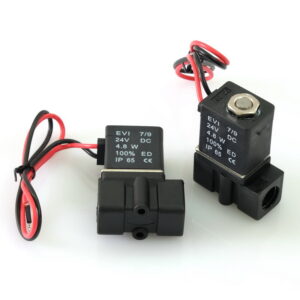 2P025-08, available branded and unbranded (STC, AitTac). I believe similar valves are provided with the StopShot and the Pluto systems (same body, different coils). The main body is plastic and this makes them a cheaper option than the Shako and the SLGPC valves. In use they are fine for medium and large drops but I am not that happy with their repeat performance or when using smaller frequent drops (this is probably more to do with the coil and size of orifice).
2P025-08, available branded and unbranded (STC, AitTac). I believe similar valves are provided with the StopShot and the Pluto systems (same body, different coils). The main body is plastic and this makes them a cheaper option than the Shako and the SLGPC valves. In use they are fine for medium and large drops but I am not that happy with their repeat performance or when using smaller frequent drops (this is probably more to do with the coil and size of orifice).
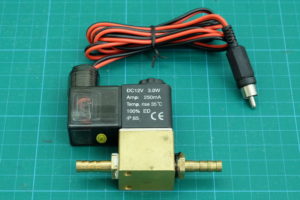 This is still my favourite type of valve, noname Chinese brand that was sold as a Shako clone but it is more like a SLGPC clone (same size block as the SLGPC). This is an old photo and I now use these valves with 24v coils.
This is still my favourite type of valve, noname Chinese brand that was sold as a Shako clone but it is more like a SLGPC clone (same size block as the SLGPC). This is an old photo and I now use these valves with 24v coils.
Most valves that have separate blocks and coils have different options for the coils. The coils can be changed, especially useful for changing the voltage, and some have clear bodies that include an LED that lights when the valve is active.
Honourable Mention
 Chuka 2V025-08, this used to be mentioned online far more than it is now. I haven’t used this valve so cannot comment on the performance but it does appear to be very similar to the AirTAC.
Chuka 2V025-08, this used to be mentioned online far more than it is now. I haven’t used this valve so cannot comment on the performance but it does appear to be very similar to the AirTAC.
Not Recommended
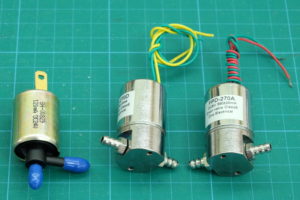 I tried several all in one valves. One was kind of OK but in general I found then too slow and difficult to maintain/clean. There are people using all-in-one valves successfully online but after trying a few I didn’t pursue them.
I tried several all in one valves. One was kind of OK but in general I found then too slow and difficult to maintain/clean. There are people using all-in-one valves successfully online but after trying a few I didn’t pursue them.
Although I put these in the not recommended section I still suggest trying different valves. You never know what works until you try.
Others
As mentioned at the start, there are many different types of solenoid valve and there will be some models that will be excellent for use in water drop photography, it is a case of try and see, and of course having time to try.
Below are a couple of valves I bought a few years ago and have never got round to trying. These have larger orifices than the PU220AR-02 and I thought they would be good for the first drop, however, the valve body is a different size/thickness compare with the PU220AR-02s and means the nozzles don’t line up horizontally. This makes getting the drops aligned very time consuming.
12v or 24v Valves?
The short answer is it doesn’t really matter. The most important thing is to match the valves (the coils) with the power supply. 24V valves with a 24v supply and 12v valves with a 12v supply.
24v valves are technically faster (very slightly) and use less current but the difference is so small you are unlikely to notice. 24V does have some benefits when using many valves due to the lower currents required.
I started with 12v valves, then added some 24v valves and for quite a while I used both (not at the same time and with different power supplies). I then settled on 24v to simplify things and upgraded some of the 12v coils to 24v ones. 24v have a benefit of requiring less current so a smaller power supply can be used. For 12v valves I recommend a minimum of 5amps and for 24v 3amps is ok. However, I still use a 24v 5amp supply so I have extra margin.
Either 12v or 24v valves will work with the dropController just match the voltage of the valve(s) with the voltage of the power supply; 12v valves with a 12v power supply and 24v valves with a 24v power supply. It is not recommended to mix different voltage valves on the same circuit.
Cleaning Valves
The below video shows how to dismantle and clean the Shako valve
Click to display the embedded YouTube video

and this one shows a slightly neglected Airtac 2V025-08 (not as neglected as the one above though).
Click to display the embedded YouTube video

The Airtacs are pretty good valves but they need more maintenance than the brass valves.
Nozzles
I have tried brass nozzles and plastic nozzles. I find the brass ones give better results with more consistent drops. The plastic nozzles tend to be unreliable, sometimes the drops are good, sometimes they are not. I feel that plastic is too “slippy” and the water drips from the nozzle when it is not active.
The smallest 1/4″ NPT brass nozzles I have found are 4mm, however, for the top drops I prefer the 6mm nozzles. The 6mm nozzles have (about) a 4mm opening and give good results. On occasion they can on occasion be too large though. When creating small drops, the drop sometimes does not drop from the nozzle. A smaller opening helps. For regular use I find the 4mm nozzles too small. They are though, ideal for use at the bottom for shoot from below.
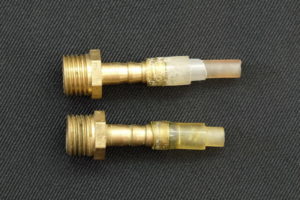 To help get smaller drops from the 6mm nozzles, I add small pieces of tube and a short length of drinking straw. Inside the straw there is another small piece of PVC tube. I still experiment with different tubes and pipes. Adding additional tubes also allows you to direct the drop and helps when aligning things.
To help get smaller drops from the 6mm nozzles, I add small pieces of tube and a short length of drinking straw. Inside the straw there is another small piece of PVC tube. I still experiment with different tubes and pipes. Adding additional tubes also allows you to direct the drop and helps when aligning things.
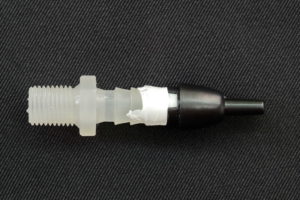 And here is an experiment that never really worked. The opening is too small.
And here is an experiment that never really worked. The opening is too small.
CNC Coolant Nozzles
Many cnc nozzles have small directional tubes which should aid with drop alignment, especially forwards and backwards, and look like they should be ideal for water drop photography. I’ve had mixed results though. Some of the shorter nozzles worked quite well but I found the longer ones to be unreliable with inconsistent drops and dribbles. I find bits of drinking straw and tube to be better, for me at least. As with most things, worth a try if you get the opportunity.
Water Tight Seal
It is important to get a water tight seal between the valve block and the nozzle. The easiest way to achieve this is with plumbers tape / Teflon tape. You don’t need a lot to make a good seal.
If the nozzle connection is not water tight, air will get in and liquid will dribble from the nozzle. This will cause odd drops and inconsistent results. When you have a good seal you should be able to see the liquid hanging slightly from the bottom of the nozzle when it is resting.
